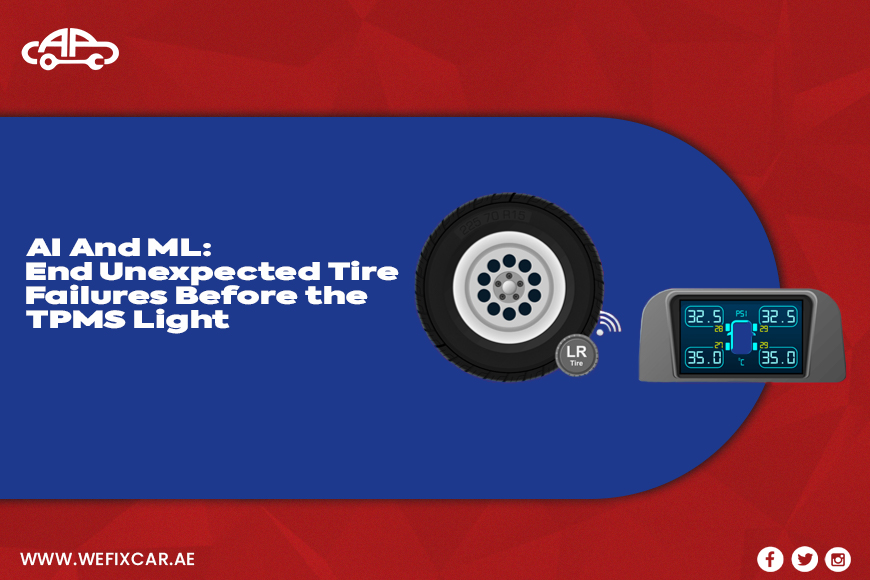AI And ML: End Unexpected Tire Failures Before the TPMS Light
Tires are easy to forget, but they’re one of the most important parts of your vehicle. They carry the weight of your car and your safety every day. Still, sudden tire failures happen all the time and are a major cause of accidents and breakdowns. Most vehicles have a Tyre Pressure Monitoring System (TPMS), which alerts you when tire pressure is low. But by the time the light comes on, it’s often already risky.
This is where Artificial Intelligence (AI) and Machine Learning (ML) can make a real difference. These technologies can spot problems before the TPMS even blinks, helping drivers and fleet managers take action early and avoid accidents.
Why TPMS Isn’t Enough
A tire can fail for many reasons, including underinflation, carrying too much weight, rough roads, or even manufacturing defects. TPMS only warns you after the pressure drops too much. That means you might have very little time to react.
Some limitations of standard TPMS:
- Late Warnings: Alerts come only when pressure is already dangerously low.
- No Forecasting: It can’t predict future tire issues.
- Environmental Impact: Hot roads, heavy loads, or uneven surfaces can affect tire health without triggering a warning.
AI and ML go beyond these limitations by analyzing tire behavior in real time. They notice subtle changes and predict problems before they become serious.
How AI and ML Work With Tires
AI and ML can process lots of tire data at once, detecting patterns that a human or traditional TPMS might miss. Here’s what they do:
1. Predict Problems Early
By studying past tire performance, AI can predict which tires are likely to fail. It looks at pressure swings, temperature changes, and wear patterns.
For example, trucks in Dubai’s desert heat face faster tire wear. AI can tell managers which tires might fail soon, so they can replace them before any accident happens.
2. Monitor Tires Continuously
Unlike TPMS, AI systems track tires all the time. They notice:
- Pressure shifts
- Temperature changes
- How is weight distributed
- Vibration or unusual movement
This means you get early warnings, not just emergency alerts.
3. Recommend Smart Maintenance
AI doesn’t just warn you; it advises. It can suggest when to rotate, balance, or replace tires based on driving patterns and road conditions. This saves money and keeps tires lasting longer.
4. Help Fleets Stay Ahead
For companies with many vehicles, AI dashboards show which tires need attention. Operators can plan maintenance, avoiding unexpected downtime, which is especially important in the UAE, where extreme heat and rough roads are common.
Read More: Tyre Blowout Prevention UAE Tips
Benefits of AI Tire Monitoring
- Safer Driving: Early alerts reduce blowouts and accidents.
- Save Money: Preventive care cuts repair costs and replacements.
- Better Fuel Efficiency: Tires in good shape use less fuel.
- Useful Insights: Analytics help fleets and drivers make smarter decisions.
- Eco-Friendly: Longer-lasting tires mean less waste.
Real-Life Example
A logistics company in Abu Dhabi had 200 trucks. Even with TPMS, tires were failing during the hot summer months. After installing an AI-based monitoring system:
- Tire failures dropped by 30%
- Maintenance costs went down by 25%
- Deliveries stayed on schedule
This shows that AI doesn’t just alert you; it helps prevent problems before they happen.
The Future of Tire Safety
Predictive tire monitoring is the future. AI and ML combined with TPMS can:
- Spot small leaks or minor damage before it becomes serious
- Adjust tire care recommendations based on load and driving style
- Extend tire life, even in harsh climates like Dubai’s deserts
As more vehicles adopt AI-powered systems, reactive tire maintenance will become a thing of the past.
Tips for Drivers
Even with AI monitoring, basic care is important:
- Check Tires Regularly: Look for cuts, cracks, or nails.
- Keep Pressure Correct: Even slight drops affect safety and efficiency.
- Watch Your Load and Speed: Heavy loads or speeding wear tires faster.
- Rotate Tires: Ensure even wear and longer life.
- Follow AI Alerts: Treat predictive warnings seriously; they come before the TPMS light.
Conclusion
Pairing AI and ML with TPMS is a big step forward for safety and efficiency. It allows drivers and fleet managers to predict tire failures before they become dangerous.
In places like Dubai and the UAE, where heat and road conditions are tough, AI-powered monitoring isn’t optional; it’s essential. With wider adoption, unexpected tire failures could soon be a thing of the past.
FAQs
1. What exactly is a Tire Pressure Monitoring System (TPMS)?
Think of TPMS as a watchful guardian for your tires. It keeps track of tire pressure and warns you if it falls too low, helping prevent sudden blowouts and keeping you safe on the road.
2. How does AI improve tire monitoring beyond what TPMS does?
While TPMS reacts to problems, AI predicts them. By studying tire behavior, driving patterns, and environmental factors, AI can spot potential issues before they become serious. It’s like having a tire expert riding with you at all times.
3. Can AI really prevent sudden tire failures?
Yes. AI keeps an eye on pressure, temperature, and even tire vibrations. If it detects something unusual, it can alert you or your fleet manager early, often days before a failure could happen.
4. Is AI-based tire monitoring useful for fleet managers?
Definitely. For companies with dozens or hundreds of vehicles, AI dashboards show which tires might need attention. This allows for planned maintenance rather than costly surprises on the road.
5. Will AI replace traditional TPMS systems?
Not really. TPMS still handles immediate alerts. AI adds an extra layer of protection by predicting problems before they reach the danger zone. Together, they make a powerful safety duo.
6. How does predictive tire maintenance save money?
Catching problems early avoids emergency repairs, extends tire life, improves fuel efficiency, and reduces downtime. In short, it helps drivers and companies save a lot over time.
7. Are AI tire monitoring systems available in Dubai and across the UAE?
Yes, more and more. Several automotive tech providers now offer AI-powered solutions that work alongside traditional TPMS, making driving safer, especially in hot and challenging road conditions.
8. What types of data does AI track in tires?
AI looks at pressure, temperature, load, speed, vibrations, and driving habits. By connecting the dots, it can identify potential issues before they cause real trouble.
9. Do I still need to check my tires even with AI monitoring?
Absolutely. AI is smart, but a quick visual check for cuts, cracks, or unusual wear is still essential. Think of it as a second set of eyes on your tires.
10. Can AI help my tires last longer?
Yes. By predicting when maintenance is needed, like rotation or balancing, AI keeps your tires performing well and extends their lifespan. Over time, this can save both money and hassle.



